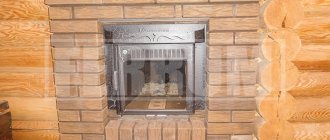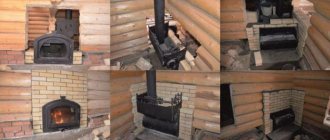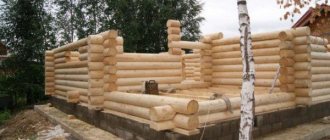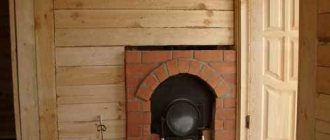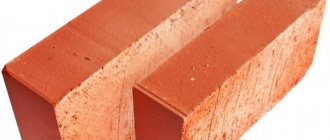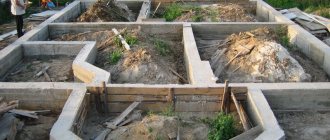The stove in the bathhouse is the basis of everything. The entire functionality of the bathhouse depends on the quality of the stove. Many options for stoves have been developed; the choice of one type or another is most often determined by the financial capabilities of the owner and his ideas about the effectiveness of this type of stove.
However, there are general requirements for the arrangement of sauna stoves, in terms of fire safety, ease of use and operational requirements. One of these issues is the proper installation of the stove and, in particular, the availability of a foundation for the stove.
Opinions differ on this issue, there are arguments for and against. Let's try to figure it out in more detail.
Do you need a foundation for a stove in a bathhouse?
Basically, the presence of a foundation is determined by the size and weight of the stove, which, in turn, depend on the overall size of the bathhouse. That is, a large volume of space requires a large stove, which has significant weight and must be supported by a sufficiently powerful foundation. Experts have determined the maximum weight of the furnace - 700 kg (some sources indicate 750 kg), which can be installed without constructing a separate foundation. For furnaces whose weight exceeds this value, the presence of a full-fledged foundation is mandatory.
For your information! This applies to buildings with a strip, column or pile-screw foundation. If the bathhouse is built on a solid concrete pad (slab type), a separate platform for the stove is not required .
To finally resolve the issue, it is necessary to consider all aspects - the weight of the furnace, the type of main foundation, the type of soil, the volume of the boiler (which can increase the total weight of the furnace several times), the material of the furnace, etc. It should be taken into account that the furnace requires a separate foundation, not connected to the general foundation of the building .
This rule is due to the need to reduce the load and eliminate deformation of the stove during any movement or subsidence of the general base of the bath. The pressure on the ground created by the walls and the furnace is different, which is why the amount of subsidence and movement varies significantly.
In addition, the response of structural elements to precipitation is not the same. Small changes that do not cause serious problems for walls and ceilings can turn into a disaster for a stove, especially for a brick one. The formation of even a small crack is fraught with the appearance of carbon monoxide, smoke, and the penetration of sparks into the room. Therefore, the need for a reliable separate base for a stove of large size and weight is undeniable .
When can you do without a foundation?
If the weight of the stove does not exceed 700 kg , or the general foundation of the bathhouse is a solid monolithic slab of concrete , a separate foundation for the stove in the bathhouse does not need to be erected. Relatively lightweight stoves, most often made of metal, have higher strength than brick ones. Such structures can even be installed on a wooden floor, while complying with all fire safety requirements. See the article about installing a metal stove.
Brick stoves are heavy, but with a common monolithic foundation they are built without any separate foundations. In this case, there is a danger of destruction of the furnace due to deformations of the base plate, so its arrangement must be taken with full responsibility.
Furnace foundation height
There are three options here:
- below floor level;
- on the same level;
- higher.
Questions may only arise about why to make the base of the furnace below the finished floor level. The answer consists of two parts:
- So that combustion air is taken from the underground. Then the stove, if you wish, can be heated from the steam room, and not from the rest room or dressing room: the oxygen in the room is not burned out, since it “stretches” from the underground. Only the foundation should have ventilation holes to allow air to flow through.
- So that the floor is warm. Despite the increased circulation in the underground, the floors with this arrangement of the stove warm up quickly. Then there will be no problems with a cold floor, be it wooden or concrete.
How to organize the supply of combustion air from the underground
Also, as a bonus, with this arrangement there are no problems with drying the floor. Only this is only true if the drainage and waterproofing of the floor is done correctly.
Everything will work if the blower is located below the level of the finished floor. If the foundation is made at the same level as the floor or higher, and air intake needs to be organized from the underground, the metal furnace is modernized (the option on the right in the photo). A thick-walled metal pipe with a gate is welded into the sidewall. The damper regulates the level of air supply and combustion intensity. Just note that if the integrity of the stove is damaged, it will be removed from the warranty (if any).
A more detailed image of the furnace limits
In the same way - by welding the pipe - combustion problems of an already installed stove are solved. Problems arise due to lack of oxygen. And it is provoked by current technologies: to reduce heat loss and heating costs, we make thermoses in our houses and baths. If you forget to make ventilation or make it insufficiently efficient, then the stove burns poorly. Here, however, there is an option that does not require making changes to the furnace: the pipe coming from the ventilation hole in the foundation is brought out in the area of the ash pit. Sometimes it is enough to bring it under the boards, sometimes you need to bring it level with the floor or a little higher. Not the best or most aesthetic option, but the stove will burn normally.
Please note that if the foundation of the stove is located close to the base of the bathhouse (house), it is necessary to make them disconnected. This means that they should not touch each other. There should be a gap between them of at least 5 mm for an iron stove and 50 cm for a brick stove. In the case of an iron stove, the gap can be filled with a layer of heat insulator (basalt cardboard).
What are the requirements for foundations for a stove in a bathhouse?
The basic requirements are as follows:
- Sustainability.
- Reliability.
- Immobility.
The quantitative values of these characteristics depend on many factors - the type of furnace, its weight, soil characteristics, immersion depth of the main foundation, etc. At the same time, there are some general rules that apply to all options.
- The minimum distance between the foundation of the entire building and the stove base is at least 5 cm.
- The minimum immersion depth of the furnace foundation is at least 50 cm. In general, the starting point is the type of general foundation, since it determines all the parameters of the furnace foundation available for construction.
- Most often, similar types of grounds are used , since the choice is based on the same requirements and conditions. That is, if the entire building is erected on a pile-screw foundation, the base for the furnace also rests on piles screwed into the corners of the base. The strip foundation of the entire building determines the immersion depth of the stove , which cannot be greater than the total depth, etc.
The calculation and design of the foundation for the furnace should be carried out simultaneously with the general work on the building, this makes it easier to prepare and install the foundation. Taken into account:
- Volume and weight of the oven.
- Soil freezing depth.
- Depth of dense soil layers.
- Soil composition.
- Seasonal fluctuations in soil water levels.
- The amount of soil heaving.
- The presence of a slope, the complexity of the terrain of the site.
Thus, all the usual parameters for choosing the type of foundation are taken into account. Accurate calculations are quite complex and require knowledge of many quantities that apply to a given soil and area. This data is not always available, and the calculation itself requires certain knowledge.
Therefore, most often in practice they are guided by general rules for both the entire building and the stove foundation . At the same time, they are guided by the principle of “necessary and sufficient,” which eliminates unnecessary waste of labor and materials. For example, if the common base is significantly deepened, then sand bedding is made under the stove, raising the level of the base and reducing the waste of cobblestone material and concrete.
Useful video
Watch the video where the stove maker explains the subtleties of the requirements for such a foundation:
Preparatory work
Before starting work, you need to determine the characteristics of the soil: strength, freezing depth, heaving, etc. The depth of construction of the structure will depend on this.
In sandy or dry soil, it should sink approximately 80 cm. In heaving soil, concrete must be placed at a depth greater than the freezing depth, which can reach 120 - 150 cm. If you plan to build a brick heater, then this rule should never be neglected.
Next you need to dig a pit. Its dimensions on each side should be larger than the foundation itself. This is necessary so that after pouring the concrete and dismantling the formwork, the voids between the concrete and the walls of the pit are filled with sand or gravel.
In the future, this filling will soften the impact of moving layers of soil on the walls of the structure.
What is the difference: brick or metal?
A metal stove is much stronger than a brick stove. Installation with a slight distortion or deformation of the base will not cause much damage to a metal stove, whereas for a brick stove such movements of the foundation mean complete failure. Hence the need for a high-strength foundation for a brick kiln. Metal stoves are usually quite lightweight, which makes it possible to do without a separately laid foundation. A foundation for an iron stove in a bathhouse is not required. For them, it is necessary to provide proper fire protection measures - asbestos sheeting, a sheet of roofing iron under a metal stove, protruding beyond the stove by at least 25 cm, and in front of the firebox - at least 40 cm .
A brick kiln, having a much larger mass, cannot tolerate deformations of the base and needs a full-fledged foundation, designed to withstand the high pressure of the kiln and compensate for shrinkage processes. There should be no connection with the common foundation, otherwise the difference in the pressure created on the foundation can lead to destruction .
What to consider when planning the foundation for a sauna stove
Let's consider the case when the weight of the stove exceeds 700 kg; the material is brick. What parameters should be used to select? In general, the choice is made for the entire building at once. The terrain of the site is taken into account - is planning necessary, how difficult or costly it will be.
Dependence on soil type
- For complex terrain, slopes or folds, it is best to use screw piles, which eliminate expensive and not always possible excavation work. In addition, they can be screwed in manually without involving complex construction equipment.
- For dense rocky soils, you can get by with a shallow strip foundation. In this case, its purpose is to level the site and establish a plane; the bearing capacity of the soil does not require complex measures.
- Soils with high groundwater levels require pile foundations. Digging a pit in such conditions is tantamount to the formation of a small lake on the site, so screw or driven piles are used, immersed in the soil to the level of dense layers.
- At greater depths of soil freezing, is made , buried below the freezing point . The depth of the pit in such cases can be more than 2 meters, which is too much for the base of the furnace. The issue is solved by the formation of a sand cushion, tightly compacted and leveled. The thickness of the cushion is such as to bring the bottom mark of the furnace base to the required height, where the next layer is laid - a butcher block or reinforced concrete slab.
- Areas with high seasonal elevation changes - soil heaving - require either a pile foundation resting on dense layers of soil and raising the entire building above ground level, or the arrangement of a solid monolithic slab , a massive, durable foundation made of reinforced concrete. Such a slab moves along with the ground surface, preventing deformation of the building fixed on it. A solid slab foundation is reliable and durable, but requires a significant investment of money and labor, since it is usually built for the entire bathhouse. A separate stove for the stove will not work in difficult and wet soil conditions; its area is insufficient.
How to choose a foundation for a stove in a bathhouse
There are not so many options to choose from - pile, monolithic slab, brick . Moreover, a pile foundation for a stove is used quite rarely , since building a bathhouse on a very problematic area is an unpopular solution; most people prefer to build on flat areas in areas with suitable soils. However, if there is no choice, you have to use a suitable option. See more information on types of foundations here.
When constructing a monolithic type foundation (the most commonly used option), the permissible depth of immersion in the ground is taken into account. Usually it is the same as the general foundation of the building, but sometimes the depth is too great - in the northern regions it can be more than 2 meters. For a furnace, such deepening is unnecessary, so it is backfilled with sand (the most correct option), gravel or bottle materials.
A brick foundation is a type of monolithic foundation, but instead of pouring concrete into a massive slab, several rows of brickwork are laid out. In terms of mechanical properties, this option is almost similar to concrete, but if it is necessary to dismantle the base, the work is significantly easier. At the same time, soils with large seasonal movements require a concrete foundation, since the brickwork can crack and lose its integrity.
In fact, all types of foundations for sauna stoves are built according to the same principle - a solid foundation placed on a dense soil layer. This or that option is simply a type of execution that is suitable in a given particular case and corresponds to the existing conditions.
Advice ! When choosing the type of foundation, it’s a good idea to consult with neighbors on the site who have already built a bathhouse, and take into account possible difficulties and mistakes.
Construction of the foundation
for a metal furnace and limit yourself to fire safety shutoffs. However, if the weight approaches the maximum value (700 kg), and it consists of the weight of water in a completely filled boiler plus the weight of stones plus the own weight of the stove , it is better to equip a separate foundation for the metal stove. To do this you need:
- Dig a pit (to a freezing depth, but not less than 50 cm), fill it with crushed stone and compact it thoroughly.
- A concrete layer is poured on top, which must completely harden. The composition of the solution is cement with sand 1:4.
- Double layer of waterproofing (roofing felt or similar sheet material),
- Filling the main slab with a solution of cement, sand, fine gravel. While the solution has not hardened, the horizontal line is checked and adjusted if necessary.
The foundation for a brick oven requires a more thorough approach and is made as strong as possible.
- A pit is being dug. Most often, this is done simultaneously with a common foundation pit for the entire building.
- A layer of sand is added to remove the bottom of the pit. Sand is poured in layers of 15 cm, each layer is spilled with water to compact it. Subsequent layers of sand are added only after the water has subsided. This technology makes sand compaction easier and provides a dense layer. After this, a rubble layer is laid - broken brick, concrete, thickness - 20 cm. Again a layer of sand, spilled with water - and so on until a dense cushion is formed that does not settle when compacted.
- A layer of crushed stone 10 cm thick is laid.
- Formwork for the main foundation slab is erected on top.
- A reinforcement frame, welded or knitted, is installed inside the formwork.
- Concrete is poured to a height that does not reach the floor level by 5-15 cm. It is kept until completely dry.
- The surface is generously lubricated with tar, several rows of brickwork are laid on top to the floor level, on which the construction of the furnace itself will begin.
Options
The most common options for building a foundation are considered, proven by frequent use and quite reliable. In some cases, other types of foundations are used, for example, pile-slab . With this method, the monolithic slab rests on piles buried to dense layers of soil.
The good thing about this method is that the possibility of settling of the bedding and the butting layer is excluded, the piles stand firmly and motionless. Driven reinforced concrete piles or screw piles are used as piles, making it possible to independently screw them into the ground. The installed piles are trimmed (extended) to the required length and tied with a channel belt (grillage), which serves as a support for the slab.
Construction for a brick oven
For a brick stove that is planned to be installed in a bathhouse, the base is constructed using a more serious technology, because the weight of such a structure is much greater than the previous one, and therefore a more powerful and durable foundation is needed for it.
In this case, the depth of soil freezing is also taken into account, which was not done in the previous version. And if this moment is missed and the foundation is built at a shallower depth than necessary, then after a short period of time it will begin to deform, crack, and deviate from the vertical axis.
The base for a brick stove for a bath is constructed in the following order:
- The first step is to determine the depth of soil freezing. This determines how deep the pit will be, which is dug below its level. Its dimensions should be 10–15 cm larger on each side than the dimensions of the future foundation. For example, if you plan to pour a foundation whose dimensions are 100 by 60 cm, then the hole will be 120-130 cm by 80-90 cm. This reserve will allow you to easily install formwork and reinforce the base with gravel or sand, which will serve as additional protection against ground movements.
- When the pit is ready, sand is poured into it, which will act as a cushion for the foundation. To compact the sand cushion, it is watered several times with water, and if necessary, new portions of sand are added. At the exit, the layer should have a thickness of 15 - 20 cm.
- After the water has gone, a layer of stones or broken bricks is laid out. It must be compacted and covered with sand. In order for the sand to fill the voids between stones or pieces of brick as much as possible, it is watered with water in several passes. When the sand stops leaving, you can stop watering and proceed to the next step. The approximate thickness of the layer of stones should be 25 - 30 cm.
- Next, a layer of crushed stone is poured into the pit and compacted.
- Now you can build the formwork. For this, a board 4 cm thick is used. The space inside the formwork and the dimensions of the future foundation must correspond to each other. A building level is used to level the formwork. The structure is securely fixed, and a metal frame is installed inside it. The distance between the boards and the frame should be approximately 5 cm.
- Next comes pouring concrete into the space inside the formwork. As you add the solution, you need to use a wooden beam for compaction. The space is filled completely so that the layer is at the level of the upper edges of the formwork. The screed is carried out and excess mortar is removed. The structure is left for several days to harden. The surface of the poured concrete should be at the zero level of the bathhouse (finished floor level). This must be taken into account when constructing the formwork.
- After the concrete has dried, the formwork can be removed. It is also necessary to melt the tar and treat all concrete surfaces with it. This must be done several times. The space between the walls of the pit and the concrete must be filled with sand or gravel. Next, the structure is covered with film and work is suspended.
- After a week, you can begin laying the sauna stove.
